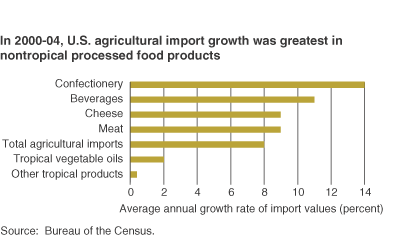Americans Have Growing Appetites for Imported Foods
- by Alberto Jerardo
- 4/1/2005
In fiscal year 2005, the U.S. trade surplus in agriculture is expected to significantly decrease, or even disappear for the first time since 1958. The reason is not so much declining exports as a surge in the value of agricultural imports, which are expected to reach $58 billion this year, up from $41 billion in 2002. Recent depreciation of the dollar played a role in this surge, contributing to a 12-percent rise in average import prices since 2001. The increase in the value of imports has been strongest in products coming from the European Union and Canada, where the U.S. dollar has weakened. U.S. demand for agricultural imports has proven to be relatively inelastic in volume (that is, rising import prices have not led to much decline in quantity consumed). Thus, a large part of the growth in the value of U.S. agricultural imports since 2001 can be attributed to higher import prices resulting from the lower exchange rate of the dollar.
Another driver of growth in U.S. agricultural imports has been a dramatic rise in consumer demand for prepared and processed foods, which, in turn, is driven by population growth, increasing ethnic diversity, and rising incomes. These preferences are seen in higher domestic sales by food manufacturers as well as a growing share in U.S. agricultural imports. The share of processed food in U.S. agricultural imports is now close to 63 percent.
Within the processed food category, the value of imports of confectionery; beer and wine; dairy products, such as cheese; and meat have grown the fastest over the last 5 years. Other fast-growing processed foods include nuts and seeds; grain products, such as flour and pasta; soft drinks; and prepared foods, such as snacks. Another major contributor to import growth is the supply of fresh fruits and vegetables during months when domestic production is seasonally low.
The volume of agricultural imports has increased roughly in line with the U.S. population, which is about 1 percent per year. The variety of imported foods, including tropical products, has increased along with the ethnic diversity of the population and consumers’ greater exposure to ethnic foods. Rising disposable incomes have made purchases of expensive foreign foods, such as wine, beer, cheese, meats, chocolate, and premium coffee, more affordable.
This article is drawn from:
- Foreign Agricultural Trade of the United States (FATUS) - U.S. Agricultural Trade Data Update. (n.d.). U.S. Department of Agriculture, Economic Research Service.
You may also like:
- U.S. Agricultural Trade. (n.d.). U.S. Department of Agriculture, Economic Research Service.


